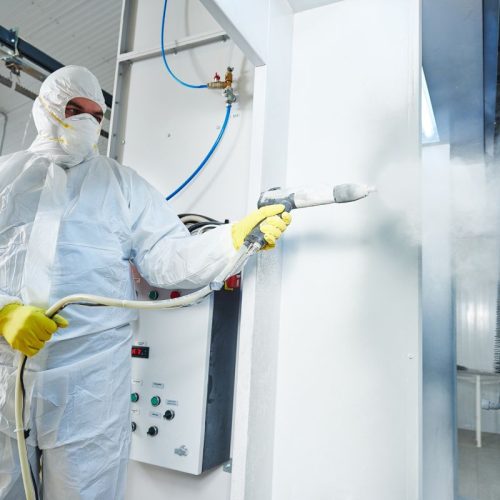What is Powder Coating?
Powder coating is a type of coating that is applied as a dry powder. This powder is applied electrostatically to a part using a specialised spray gun and then cured under heat or using an ultraviolet light.
Powder coating is used to create a tough, durable finish that outlasts traditional paint. It enhances resistance to corrosion and UV exposure, extending the lifespan of parts or materials with minimal maintenance. A wide range of powder coating colours is available, allowing you to add vibrant, long-lasting colour to your project.
The Powder Coating Process
Surface Preparation / Pre-Treatment
Before the powder coating can begin, the surface of the metal must be clean from any oils, dirt, rust and other contaminants. This step is incredibly important, as it can significantly affect the quality, durability, and adhesion of the powder coating. Surface preparation helps to:
- Ensure strong adhesion: Powder coating bonds mechanically and chemically. The presence of any oil, rust or dust may cause the powder not to stick properly. Poor adhesion can lead to peeling, flaking or chipping over time.
- Prevent defects: Contaminants can cause bubbling, craters, fisheyes or uneven textures during curing.
Increased durability and corrosion resistance: If rust or grime is not removed, it can continue to corrode after the coating process, weakening the part from the inside out. - Reduces waste and rework: Skipping or rushing part of the process could lead to recoating or scrapping the part. Proper prep helps to minimise waste and save time.
Powder Application
Once the surface has been prepared properly, powder is applied using an electrostatic spray. This is done using a specialised spray gun which gives the powder particles a positive electrostatic charge.
While the item is grounded, it has a neutral or negative electrical charge. The charge difference causes the powder to attach to the surface of the material, allowing the powder to adhere to the surface of the component.
The powder itself is typically made of polyurethane, polyester, epoxy or PTFE and helps to make materials more durable and corrosion resistant.
Curing
Once the powder has been applied, the part/material is placed in a curing oven at a high temperature. This causes the powder to melt and chemically react to form a hard, durable, uniform finish. Temperatures during this process are typically between 160°C to 220°C, and curing time can range from 10-20 minutes, depending on the powder type and the thickness of the material/part.
Cooling & Inspection
After curing, the coated item will be cooled and inspected. The result is a smooth, even finish that resists corrosion, fading, chipping and scratching. Here at G&S, we have a thorough inspection process to ensure that you get the highest quality components for your project.
Powder Coatings We Offer
E-Prime – Epoxy
E-prime is a modified epoxy powder coating used to provide additional protection to sharp profiles/edges or complex metal shapes. Epoxy is especially suited to aluminium powder coating, hot-dipped galvanised or other porous metals.
Some of the key benefits include:
- Excellent for use as a primer
- Long-lasting coating life
- Hard wearing / serviceable finish
- Less waste and environmental pollution
- Resists oil and general chemical spills
Dulux – Polyester
Dulux polyester powder coating is a high-performance topcoat finish for use in both indoor and outdoor applications. It offers excellent durability, UV resistance and plenty of powder coating colours.
Some of the key benefits include:
- Excellent UV and weather resistance
- Retains colour and gloss over time
- Tough, durable finish
- Wide range of colours and finishes
- Superior corrosion protection when used with a compatible primer system
Interpon
Interpon is a globally recognised coating brand known for its high-performance finishes used across architectural, automotive, industrial and consumer product sectors.
Some of the key benefits include:
- Available in a wide range of colours and gloss levels
- Suitable for architectural aluminium, steel and galvanised substrates
- Excellent UV and weather resistance
- Meets international standards
- Tough, durable finish resistant to chipping, scratching, and fading
Benefits of Powder Coating
Powder coating is used throughout a large range of industrial projects. Some common places you may see powder-coated materials include street light poles, traffic signal poles, banner poles and more.
Its popularity comes from its durability, environmental friendliness, and ability to provide a high-quality, long-lasting finish. Here are some of the key powder coating benefits:
Weather and UV Resistance
Powder coating provides excellent resistance to UV rays, moisture, and extreme weather conditions. This makes it ideal for outdoor applications such as poles, signage, and public infrastructure that are constantly exposed to the elements.
Durable and Long Lasting
Powder coating forms a hard, protective finish that resists chipping, scratching, corrosion and general wear and tear. Highly durable and easy to maintain, powder-coated materials are fantastic for most outdoor and architectural applications.
Environmentally Friendly
Unlike traditional liquid paints, powder coating contains no solvents and releases virtually no volatile organic compounds (VOCs) into the atmosphere. This makes it a safer, more sustainable option for both the environment and the health of workers applying the coating.
Cost Effective
Although powder coating has a higher initial cost, it often reduces the time and money spent on maintenance and repainting costs due to its durability and long-lasting finish. Its resistance to chipping, fading, and corrosion means fewer touch-ups and a longer service life, making it a smart long-term investment.
Limitations and Considerations
While powder coating is a fantastic tool, it does have some limitations. Some of these limitations include:
Material Compatibility
Powder coating works amazingly for metal substrates such as steel and aluminium. However, it’s not suitable for a variety of materials, including wood, rubber and plastic.
Upfront Cost
Compared to painting the material, powder coating can be quite expensive, making it less practical for short-term, small-scale or one-off jobs.
Common Powder Coating Applications
Some common applications of powder coating include:
- Architectural & Decorative Poles
- Banners
- Camera Poles
- Communication Poles
- Mid-Hinged Poles
- Railway Signals
- Power Poles
- Street Lights
- Traffic Signal Poles
Why Choose G&S For Your Powder Coating Finishes?
At G&S Industries, we specialise in powder coating finishes for both commercial and public installations. We are a leading manufacturer of quality poles and columns with one of the largest product ranges in Australia.
If you are interested in high-quality powder coating finishes for your project or want to know more about what we offer, be sure to contact one of our friendly team members today!

